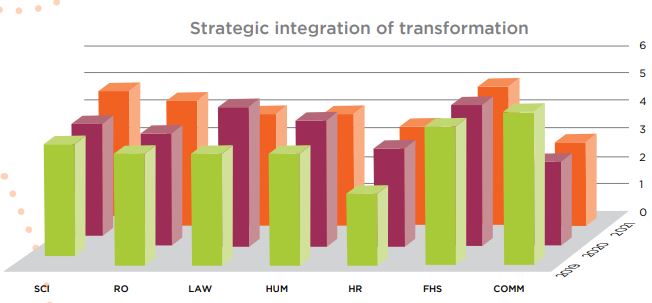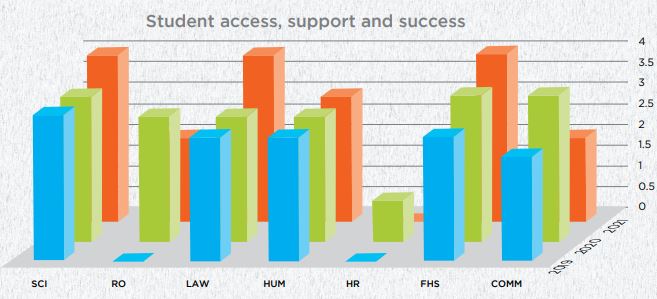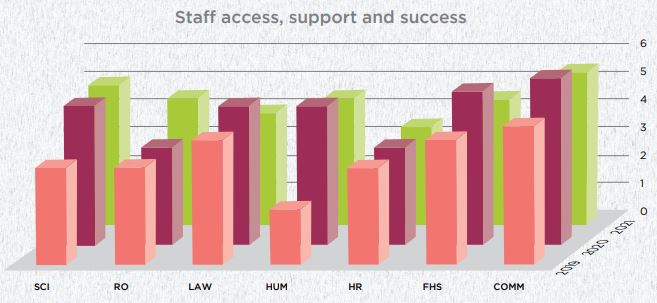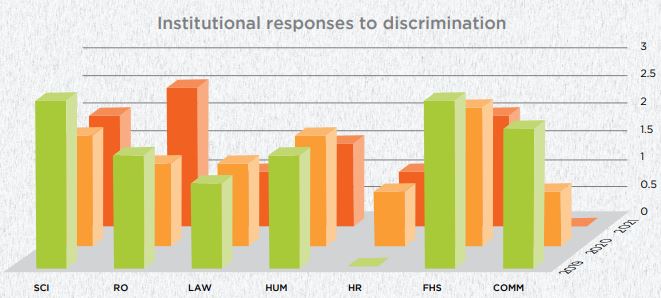Looking back at the benchmarks: 2019–2021
04 November 2022
The transformation benchmarks were assessed for a third time in 2021. This section describes the benchmark categories and backgrounds on the benchmarks.
 |
A Strategic integration of transformation | Within the institution, how well is transformation mainstreamed in basic strategic actions? |
 |
B Student access, support and success | How is the institution supporting diverse students with disparate backgrounds to be included, to fully participate and to succeed within UCT? |
 |
C Staff access, support and success | How is the institution supporting diverse staff members from disparate backgrounds to be included, to fully participate and to grow within UCT? |
 |
D Place and space: language, names, symbols, artworks and identityersity | How is the university affirming the dignity, acknowledging the contributions and experiences of, and placing special attention on those who have been historically marginalised? |
 |
E Institutional responses to discrimination, harassment and violence | How is the university practising its zero-tolerance approach to any form of unfair discrimination, harassment, sexual violence and behaviour that demeans others? |
 |
F Community engagement: anchoring UCT in community | How is the university supporting, building solidarity with, and providing professional services to communities? |
 |
G Curriculum support: decolonisation, marginalisation and accessibility | To what extent is the curriculum and pedagogy employed meeting the needs of and accessible to marginalised persons? How has curriculum, pedagogy and the broader learning environment been decolonised? |
 |
H Owning UCTʼs Afrikan identity | How is the university centring its Afrikan identity through scholarship, teaching and learning practice, or activist initiatives? |
 |
I Innovations, alternative approaches and best practices | What innovations and best practices have been employed to further transformation, inclusivity and diversity? |
Background on the benchmarks
The benchmarking approach is adapted from the United Nations Women’s System-wide Action Plan (UN-SWAP) system-wide action plan monitoring matrix, the UN World Food Programme’s (WFP) gender-transformation benchmark matrix, the Transformation Barometer (Keet & Swartz, 2015), and the AIDS and Rights Alliance for Southern Africa’s (ARASA) qualitative approach to mapping access to human rights in southern and East Africa. Benchmarks offer a standard or reference point to which entities within UCT can be compared. This set of standard actions was analysed in 2019, 2020 and in this report.
The data collected in 2019 offered a baseline for UCT and the 2020 results offer a second data set. While this year’s third data set is a further step in UCT’s journey towards 2030, it’s important not to compare the three years. Firstly, three years is too short a period to see real change. Secondly, 2020 and 2021 were years with unique challenges and it would be unfair to expect improvement in the university’s benchmark scores. Rather, the benchmark results can assist the university to define its areas of strength, gaps and thematic areas which can inform future strategy.

Feedback and criticism provided on the benchmarks
Often the concepts of transformation, diversity and inclusion (TDI), the work these concepts do and the authority and value that they hold, are considered innately (everyone is accountable for “doing transformation” work) or necessarily liberatory. This is an assumption that should be challenged, particularly when the cohesion between the academic and transformation objectives is absent or when staff and student transformation approaches are dislocated. The result of misalignment or dislocation is that TDI interventions run the risk of reinforcing disparities and inequalities. Ellsworth (1989) argued that words used in TDI intervention such as “empowerment” or “dialogue” can and are used to sustain oppressive power dynamics, and Sara Ahmed (2004) suggests that anti-racist (and other TDI) interventions in higher education often do more to sustain racism than dismantle it (Khan & Marnell, Reimagining wellbeing: Using arts-based methods to address sexual, gender and health inequalities, 2021). These examples open up TDI work and the ways in which it is monitored and evaluated to critique and, in doing so, imply that efforts should carefully assess how systems of power are changed, challenged or troubled, rather than simply assuming that concepts (such as TDI) are effective in conducting the political and social work they are supposed to do.
Some of the criticisms put forward in previous years are important to capture here for new readers of UCT’s Transformation Reports:
- Benchmark approaches prioritised naming, framing, numbering and coding of information. In doing so, much of the social phenomena of TDI work, including the diverse and sometimes contradictory ways persons understand these concepts, is lost. In focusing on capturing the benchmark score or code, the being, state and conditions of the social actors in TDI work is lost. Apthorpe (1996) argues that this leads to hierarchies and “top-down” values being entrenched over “bottom-up” or participatory approaches.
- Bell, Canham, Dutta & Fernandez (2019) suggest that the treatment of decolonialism (among other TDI efforts) as an operational and programmatic intervention un/intentionally invisibilises, surveils, codes, quantifies, and disciplines in the effort to meet its goals and targets. The operationalisation and professionalisation of TDI work entrenches it in existing power structures, at the expense of creative, activist, anti-capitalist and imaginative alternatives. However, there remains an alternative where transformation operations and professionalisation coexist as a critical ally to a system that authentically seeks to change. The determining factor is to understand who the system seeks to change and serve, and whether the “work of transformation” responds to those needs in a way that is relevant.
- Faculties and non-academic departments have also put forward critiques of this approach:
- The primary criticism of this approach is that the amount of data and evidence expected for the report is daunting. Entities within the university continue to struggle to set time aside to complete the report. On average, only 13 entities submitted reports each year between 2019–2021, and many entities have not been able to complete their reports.
- Another entity highlighted that the benchmark framework didn’t respond to or criticise how institutional governance structures and systems fail staff and students, and rather allocated a poor score to a department or faculty. This seems to take responsibility and accountability away from a biased and exclusionary institution, and places responsibility on individual entities within the university.
- Lastly, some entities continue to argue that the benchmarks are “not applicable” to them. For example, several non-academic departments don’t see their work as intersecting with students. Even though this has been challenged in both the 2019 and 2020 reports, some departments continue to use “N/A” as their response to student-related issues and struggles. This leads to some entities (responsible for policy development, etc) being distant, disengaged from and potentially dismissive of student struggles.
All these criticisms are important in making sense of the opportunities and limits this benchmarking approach provides. These criticisms, alongside a deep evaluation after five years of implementing benchmarking, would provide a good basis for assessing its effectiveness and proposing an adapted or different approach moving forward. Even with these challenges, the approach allows for trends related to TDI to be made visible and for these trends to inform the priorities and practices of the university. Along this continued trajectory, it will be difficult at the five-year mark to demonstrate that inclusion has increased in the university.
Looking back at the data between 2019 and 2020
The primary purpose of the benchmark approach and results is to map out progress in relation to transformation at an institutional level (see section 3.2 for institutional results). The results are also useful in tracking how specific departments or faculties are progressing in terms of achieving the benchmarks. This subsection shares the results of a small group of entities over the past three years as examples.

Above: For benchmark A, entities on average meet between 55-60% of the benchmark requirements. While some entities, like theFHS, have been consistent in meeting many requirements of this benchmark, others like the faculties of Commerce, Humanities and Law , and the HR Department seem less consistent. Conversely, the RO and Science faculty have shown some signs of improvement.

Above: For benchmark B, the peaks and the dips are more clearly visible. In this case, the peaks are most clearly available for the faculties, while the dips are most clearly visible for the non-academic departments. For three faculties (Health Sciences, Law and Science), the peaks emerge in later years. This could possibly indicate that more efforts are being made in this area. The RO and HR emerge as gaps in this benchmark. While the RO does meaningful work to support, engage and collaborate with new graduates (often from historically excluded groups) this work may not explicitly deal with systemic racism, SGBV or xenophobia, among other systems of violence. While HR doesn’t directly serve students, more could be done to support graduate students who are interested in entering academic or research professions. However, due to the rough and uneven terrain visible in this graph, the peaks and dips in this graph should be viewed as possibilities rather than certainties. The peaks offer the possibility of good practices, and the dips the possibility of challenges, barriers or gaps.

Above: For benchmark C, entities meet between 55-60% of the benchmark requirements. For this benchmark it seems that staff support work is growing inconsistently within entities. Only three entities (the Commerce, Health Sciences and Science faculties) were able to meet five of the benchmark goals, with the majority reaching fewer than that number.

Above: Benchmark E, like benchmark B, makes the dips and peaks more visible. In this case, and in contrast to the other graphs, we can clearly see a reduced number of actions for many entities. The faculties of Commerce, Health Sciences, Humanities, Law and Science all reported fewer actions related to this benchmark. This could indicate that it is a waning priority.
These graphs are offered as examples of the ways in which the benchmark scores between 2019–2021 can be used to make sense of the transformation context in UCT. These examples suggest the following challenges and opportunities:
Opportunities
- Overall, the benchmark scores can offer a map or indication of where TDI priorities are positioned and work is occurring. In making the dips and the peaks visible, it indicates where good practices are likely occurring and where gaps are present.
- In doing so, it can assist the transformation portfolio to reframe its work or reprioritise actions to better support the spaces in need, or to enable and scale-up effective actions.
- While the data set for the first three years (2019–2021) is insufficient to justify any statements about trends, it does begin to indicate the direction entities in the university are going in terms of TDI. This indication, if tracked over time, can map progress or decline in TDI.
Challenges
In conclusion, the benchmark approach offers a useful and standardised way to track actions related to TDI at UCT. While there are many challenges, documented above, the approach allows for an indication of peaks (possible good or effective practices) and dips (challenges or gaps), and this can assist the transformation portfolio to reformulate its approach, better enable good practices, and better support entities in need.
- It’s important to acknowledge that the quantity of the score doesn’t always match up with the quality (or more accurately impact) of the action undertaken. The quality of the intervention or programme is represented through the qualitative submissions by faculties and departments. For example, under benchmark C, some entities may report a once-off event to support staff, while others might be implementing a structured programme for staff development. The impact of the former would be much smaller than the latter, but both would be able to achieve a sub-benchmark score.
- In addition, the benchmark scores don’t take into account environmental factors. For example, COVID-19 led to entities reprioritising actions, budget limitations and additional stressors. This is likely to have impacted how and which transformation actions were prioritised in the past two years.
- Even with three years of data collection and data available from the same set of entities, it is still difficult to make clear statements about the direction the university is going in terms of TDI. There are not clear indications of decline, progress or stagnation, as yet. This exercise will need to be run for several more years before enough data is available.
- It’s important to note that many entities submitted very similar reports over the years. This could mean that actions occur over many years, or that entities are reporting the same action several times over the years. This impacts the efficacy of the scores and the qualitative narratives collected for the individual years, but they are still useful for the overall story of transformation.
In conclusion, the benchmark approach offers a useful and standardised way to track actions related to TDI at UCT. While there are many challenges, documented above, the approach allows for an indication of peaks (possible good or effective practices) and dips (challenges or gaps), and this can assist the transformation portfolio to reformulate its approach, better enable good practices, and better support entities in need.
 This work is licensed under a Creative Commons Attribution-NoDerivatives 4.0 International License.
This work is licensed under a Creative Commons Attribution-NoDerivatives 4.0 International License.
Please view the republishing articles page for more information.






